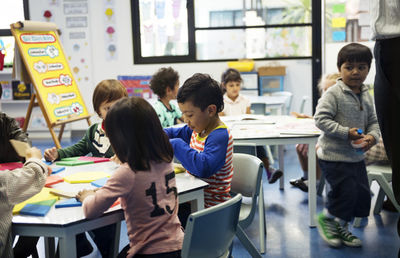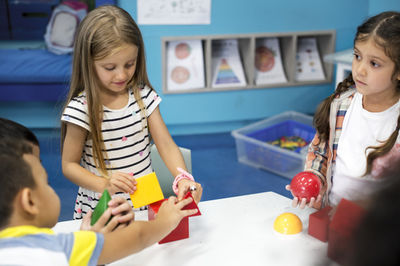5 Keys to become a great EFL Kindergarten Teacher

Of all the hard jobs around, one of the hardest is being a good teacher. So how is it possible to become a great teacher? And how can a teacher become great at helping young learners in a kindergarten class who have little to no experience learning in a classroom setting? Although challenging at times, it can be done. There are a few keys to being a great kindergarten teacher.
Table of Contents
1. Teacher's Attitude and Mindset
3. Support Teaching With Visual Aids
Do you want to become a TEFL teacher? It's so easy. Take a TEFL course right now!
Listen to this blog post:
This post was written by our TEFL certification graduate Julia W. Please note that this blog post might not necessarily represent the beliefs or opinions of ITTT.
1. Teacher's Attitude and Mindset
The first key is to develop the right mindset before entering the classroom. It is important for a teacher to cultivate a sincere desire to care about each student in the class and a desire to help each student succeed. A great teacher really needs to love teaching and to love his or her students as well. If so, this will be reflected in the attitude that the teacher brings into the classroom each day. When the children observe the enthusiasm of the teacher, the students will be motivated to try their best. I learned the hard way how important this really is. One of the first kindergarten classes I taught in China posed a real challenge to me. A few of the students were unruly and did not want to participate in any of the class activities. As a result, I became frustrated with them and it affected the way I taught the entire class for several weeks. In retrospect, I wish I would have tried harder to build rapport with all the students and develop even greater concern for these students in an effort to help them grow instead of becoming frustrated. My attitude and feelings toward the class had a negative impact on my mindset and therefore on my teaching.

Also Read: The 15 Most Asked Questions in a TEFL Interview
2. Preparation
The second key is to prepare well before each class. In my past experience, the classes that I prepared well for were executed the best, and both the students and I enjoyed them the most. Good preparation involves developing a well thought out lesson plan that includes a class warm up and a rapport building section. Following the warm-up, well-prepared activities should be planned for the engage, study, and activate sessions of each class. Young learners especially have short attention spans, so each activity should be kept short and highly interactive.
3. Support Teaching With Visual Aids
A third key is to keep the classroom and all activities visually appealing and stimulating. Young learners absorb information the best when they are able to use all their senses. Therefore, using lots of colorful visual aids as well as audio and video tools will help to keep the children engaged. Planning activities that allow the students to get out of their seats, move around the class, and touch different objects will also assist in the learning process. One of the most successful kindergarten classes I remember was teaching colors and shapes to students in China. I had many shapes of different colors cut out from cardboard paper, and I played a game where the students who could identify the shapes and colors were able to hang onto the shape for the rest of the class. They all loved being given something to touch and hold on to, and the students were excited and engaged for the entire duration of the class. Young children learn extensively through games and music as well, so incorporating these stimulating activities into the classroom will make it very effective.

Also Read: What is the difference between TESOL and TEFL?
4. Encourage to Use English
A fourth key is to encourage the students to use English as much as possible and give them plenty of commendation. In the past, I often resorted to using Chinese in an effort to communicate with my students. However, I found that it did not help them to improve their English, nor did it help me to teach them. Young learners can absorb a new language just by listening to it and repeating it. So promoting the use of English in the classroom as much as possible will help them to learn the language. Additionally, giving them lots of commendation and encouragement will help them feel good about coming to class and help them develop confidence in using the English language.
5. Keep it Fun!
The fifth and final key is to make every part of the class fun! Young learners enjoy play and much of their day is spent playing with toys and games. This is how they learn. So if the teacher can incorporate lots of fun into the lessons, the classroom will be very conducive to learning. In fact, they will be learning English without even realizing it!
Do you want to become a TEFL teacher? It's so easy. Take a TEFL course right now!
There are many more keys to becoming a great teacher and an endless amount of books have been written on the subject. But following a few of these simple keys can help any teacher to be great at teaching English in the kindergarten classroom. By utilizing the many essential lessons I have learned through past experience, as well as the valuable training that I have received from the TEFL course, I hope to be a great kindergarten teacher.
Apply now & get certified to teach english abroad!
Speak with an ITTT advisor today to put together your personal plan for teaching English abroad!
Send us an email or call us toll-free at 1-800-490-0531 to speak with an ITTT advisor today.
Related Articles:
- TEFL Breakdown - What Subjects Will Your TEFL Course Cover?
- 5 Reasons Why Teaching English Abroad Enhances Your Career Prospects
- Top 5 Tips: How to Learn a New Language When Teaching English Abroad
- 4 Top Tips for Getting Your TEFL Certificate on the Road
- The How-To Guide for Americans to Teach English in Europe
- 5 Great Places to Teach English Abroad Without a Degree



